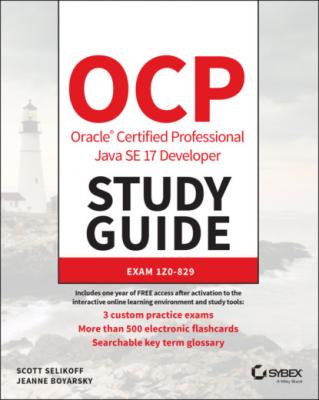OCP Oracle Certified Professional Java SE 17 Developer Study Guide. Jeanne Boyarsky
Чтение книги онлайн.
Читать онлайн книгу OCP Oracle Certified Professional Java SE 17 Developer Study Guide - Jeanne Boyarsky страница 20
 and initialization. It also teaches you how to create abstract classes and overload methods.
and initialization. It also teaches you how to create abstract classes and overload methods.
Chapter 7: Beyond Classes introduces many top-level types (other than classes), including interfaces, enums, sealed classes, records, and nested classes. It also covers polymorphism.
Chapter 8: Lambdas and Functional Interfaces shows how to use lambdas, method references, and built-in functional interfaces.
Chapter 9: Collections and Generics demonstrates method references, generics with wildcards, and Collections. The Collections portion covers many common interfaces, classes, and methods that are useful for the exam and in everyday software development.
Chapter 10: Streams explains stream pipelines in detail. It also covers the Optional class. If you want to become skilled at creating streams, read this chapter more than once!
Chapter 11: Exceptions and Localization demonstrates the different types of exception classes and how to apply them to build more resilient programs. It concludes with localization and formatting, which allow your program to gracefully support multiple countries or languages.
Chapter 12: Modules details the benefits of the new module feature. It shows how to compile and run module programs from the command line. Additionally, it describes services and how to migrate an application to a modular infrastructure.
Chapter 13: Concurrency introduces the concept of thread life cycle and thread-safety. It teaches you how to build multithreaded programs using the Concurrency API and parallel streams.
Chapter 14: I/O introduces you to managing files and directories using the I/O and NIO.2 APIs. It covers a number of I/O stream classes, teaches you how to serialize data, and shows how to interact with a user. Additionally, it includes techniques for using streams to traverse and search the file system.
Chapter 15: JDBC provides the basics of working with databases in Java, including working with stored procedures and transactions.
At the end of each chapter, you'll find a few elements you can use to prepare for the exam:
Summary This section reviews the most important topics that were covered in the chapter and serves as a good review.
Exam Essentials This section summarizes highlights that were covered in the chapter. You should be able to convey the information described.
Review Questions Each chapter concludes with at least 20 review questions. You should answer these questions and check your answers against the ones provided in the Appendix. If you can't answer at least 80 percent of these questions correctly, go back and review the chapter, or at least those sections that seem to be giving you difficulty.
To get the most out of this book, you should read each chapter from start to finish before going to the chapter-end elements. They are most useful for checking and reinforcing your understanding. Even if you're already familiar with a topic, you should skim the chapter. There are a number of subtleties to Java that you could easily not encounter even when working with Java for years. For instance, the following does compile:
var $num = (Integer)null;
Even an experienced Java developer might be taken aback by this one. The exam requires you to know these kinds of subtleties.
Conventions Used in This Book
This book uses certain typographic styles to help you quickly identify important information and to avoid confusion over the meaning of words, such as on-screen prompts. In particular, look for the following styles:
Italicized text indicates key terms that are described at length for the first time in a chapter. (Italics are also used for emphasis.)
A monospaced font indicates code or command-line text. We often use bold to highlight important words or methods within a code sample.
Italicized monospaced text indicates a variable.
In addition to these text conventions, which can apply to individual words or entire paragraphs, a few conventions highlight segments of text.
Sidebars
A sidebar is like a note but longer. The information in a sidebar is useful, but it doesn't fit into the main flow of the text.
A real-world scenario is a type of sidebar that describes a task or an example that's particularly grounded in the real world. This is something that is useful in the real world but is not going to show up on the exam.
Getting Help
Both of the authors are moderators at CodeRanch.com. This site is a quite large and active programming forum that is friendly toward Java beginners. It has a forum just for this exam called Programmer Certification. It also has a forum called Beginning Java for non-exam-specific questions. As you read the book, feel free to ask your questions in either of those forums. It could be that you are having trouble compiling a class or are just plain confused about something. You'll get an answer from a knowledgeable Java programmer. It might even be one of us!
Remember to check our book page before taking the exam. It contains any recent updates Oracle makes to the exam.
www.selikoff.net/ocp17
Interactive Online Learning Environment